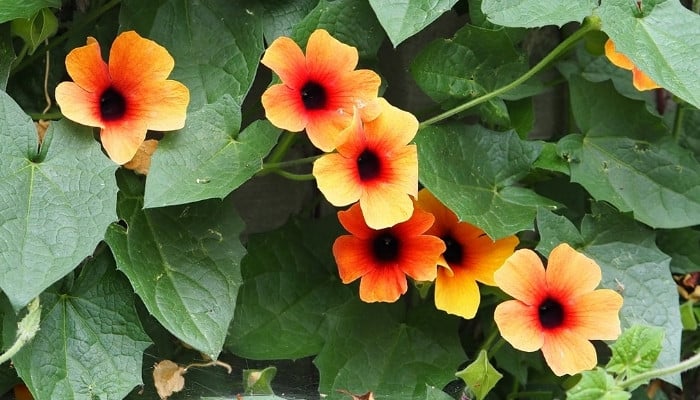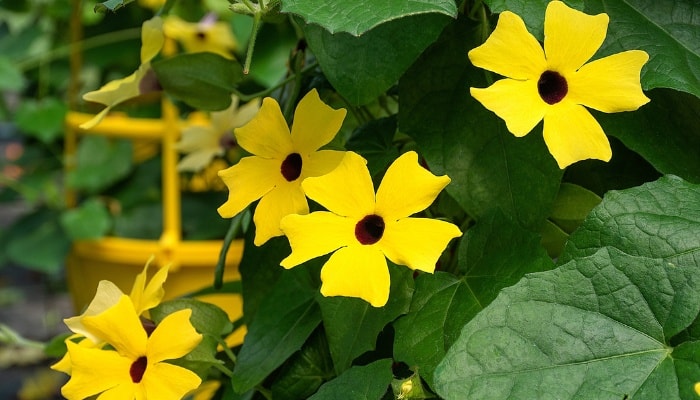A plant called the black-eyed Susan vine, scientifically known as Thunbergia alata, flourishes in a mild environment with ample sunlight. It serves as a lovely hanging plant or can be trained to climb up a trellis, adding a stunning touch to any garden.
Use this vine to create privacy along a fenceline or make it a focal point with its eye-catching bright orange or yellow flowers with dark centers.
How do I get my black-eyed Susan Vine to bloom? Your black-eyed Susan vine may need different growing conditions to bloom. Providing cooler temperatures, giving it time to mature, supplying more nutrients, or increasing sunlight exposure will help it bloom. It may also need a nutrient boost to provide the necessary elements it needs to bloom.
To understand what it takes to get your black-eyed Susan vine blooming, continue reading! Here, you’ll learn the top 7 reasons why it’s not blooming and a solution for each. Your pretty vine will be blooming again in no time!
Black-Eyed Susan Vine Not Blooming: 7 Common Reasons
A plant’s main objective is to flower, but sometimes the environment isn’t as favorable as the plant needs it to be. With inadequate fertilization or poor environmental conditions, your black-eyed Susan will just be a bunch of green leaves.
Check out what could be wrong with your vine below, make a few observations, and change anything you can to make its growing conditions more favorable!
1. Too Hot
Native to Africa, this vine grows best in USDA Zones 10 or 11, so it is used to the heat in most cases. It is a tropical vine that needs humidity, moderate sunlight, and an environment with few temperature fluctuations.
When a plant is too hot, it won’t want to exert its resources to grow flowers. Flowering is water-costly to a plant, and if it is uncomfortable in the environmental conditions, it won’t want to reproduce (i.e., produce flowers).
What To Do
Try to plant your vine in an area that is partially shady. Shade can reduce ambient temperatures by 10 to 15 degrees, hopefully just enough to make the plant happy. Be sure to still give the plant 6-8 hours of direct sunlight to make it thrive.
2. Vine Too Young To Bloom
A plant will only flower once it has reached its sexual maturity. Luckily the black-eyed Susan vine doesn’t take years like some perennials plants and should begin to flower after about 6 to 12 weeks.
It may also fail to bloom bountifully because it isn’t that large yet. Over time, it will grow large and mature enough to produce many more flowers all at once.
What To Do
All you can do is wait! Gardening is often a patience game, and unfortunately, this is one of those cases. Luckily, the wait is always worthwhile!
You can be sure it will flower once it reaches maturity by fertilizing it at least once a year in the spring right before the flowers bloom.
3. Poor Soil Quality
Every plant needs three vital nutrients (nitrogen, phosphorus, and potassium along with many trace minerals) to grow, flower, and sustain life. Without these, the plant may not flower, will have difficulty growing leaves, or even die.
If it is not flowering, the problem is most likely a deficiency in phosphorus or potassium in particular. A soil test will pinpoint the problem for you.
What To Do
Fertilize the vine yearly in the spring before the flowers open. A fertilizer low in nitrogen specifically designed for flowering plants will help it receive all the nutrients it needs. This one is fantastic!
Also, mix some compost with the native soil to improve soil quality.

4. Lack of Sunlight
This vine thrives in full sun, and without enough sunlight, it won’t want to flower. The hours of sunlight signal to a plant what season it is.
If it never receives adequate sunlight, it won’t know to produce blooms when it is supposed to. It will also not be able to produce a sufficient amount of energy to produce prolific blooms.
What To Do
Move your plant into an area that receives a minimum of 6 hours of full sun per day to encourage more blooms. Your vine will prefer it even more if it receives 8 hours of sun with a bit of partial shade in the hottest afternoon hours.
5. Incorrect Fertilization
While you may think fertilizing is easy and always helps, it can be done incorrectly! A fertilizer with too much nitrogen will result in too much foliage growth at the expense of flowering.
It needs all three nutrients to flower, and if it doesn’t receive them, it won’t flower!
What To Do
If you notice that your vine is always growing bountiful leaves with no flowers season after season, fertilize it with a high phosphorus and high potassium fertilizer (see recommendation above).
This will help balance the nutrients and promote flower growth.
6. Irregular Watering
Without an ample supply of water, along with nutrients, the vine will want to reserve its resources and won’t flower.
It is best to always check your soil to make sure the soil dries out in between waterings but not for too long. This will provide the correct amount of water and air for the roots to thrive.
What To Do
Set up a drip irrigation system to make it easy to water regularly and efficiently. Be sure to adjust your watering schedule if necessary because regular watering doesn’t necessarily mean correct watering.
It is good to periodically check the soil moisture to make sure it is receiving enough but not too much. If the soil is still moist, hold off watering for a day or two.
7. Cold Temperatures
Temperatures that are too cold will keep the plant growing slower than in an average climate. Since this vine doesn’t do well in the cold, it won’t be able to grow flowers and reproduce.
Cold spells can even damage buds, causing the vine to drop its buds and never bloom.
What To Do
If you know a cold spell is coming, wrap your vine in burlap to help keep it warmer and protected from frost. Sometimes there isn’t anything you can do, unfortunately. Mother nature can take its toll when temperatures fluctuate quickly.
Try planting your vine in an area of your garden that doesn’t get too cold and mulch heavily, or if it is planted in a pot, bring it inside during cold spells to keep it safe and protected.
Black Eyed Susan Vine in Container – How To Help It Bloom
Anytime a plant is grown in a container, it requires different care than if it were to be planted in the ground.
With less soil space and an inadequate amount of organic materials, you’ll need to fertilize your vine at least once a year. This is especially important if you’re growing it as a perennial.
A well-balanced fertilizer mix that has an N.P.K. near 5-5-5 will do wonders! Vines grow quickly and will need copious nutrients to continue to grow and bloom.
It will grow best if you give it something on which to grow! Plant it with a trellis, and train it by guiding it around to keep it from growing over the top.
You’ll need to prune the stems back if it gets too long, but be aware this will cause it to branch out more.
Related Questions:
Is Black-Eyed Susan Vine a Perennial?
Although the vine is grown as an annual in most climates, it will easily thrive as a perennial in warmer climates! In USDA Zones 10 to 11, it will have no problem growing year after year.
How Fast Does Black-Eyed Susan Vine Grow?
Black-eyed Susan vine inherently grows faster than most species of plants. Averaging 8 to 10 feet per growing season, it will amaze you to see it grow!
Final Thoughts
Most people don’t realize that there is a vine species of the black-eyed Susans as well! It makes a great wall or fence covering and adds color and beauty everywhere it grows.
Now that you know how to correct flowering issues, you can once again look forward to enjoying the cheerful display of blooms throughout the season. Good luck!

